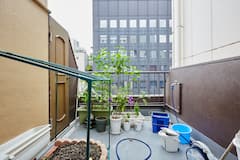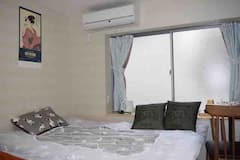Though Japan is often the first country that pops to mind when thinking of technological advancements, the Land of the Rising Sun is just as steeped in history and centuries of culture. The traditional Japanese theatre that exists today is both a homage to the art form and a promotion of Japanese cultural contributions. Kabuki (Japanese dance-drama), noh (song-and-dance drama) and nihon buyo (dance and pantomime) are a few art forms that are being enshrined and performed to this day in Japan. A visit to a Japanese theatre in any part of the country will not only be immensely entertaining - it is also sure to take you back hundreds of years! Read on to discover traditional theatres in Japan you can check out when you find yourself in the country.
1. Minamiza Theatre

As Kyoto’s primary theatre, Minamiza dates all the way back to the Edo period. The 400-year old theatre had humble beginnings, around when the dry bed of the Kami River took on new life as a ‘theatre town’ bustling with the best of Japan’s cultural shows. The theatre continues to be at the heart of Kyoto’s kabuki productions and was assigned the title of Registered Tangible Cultural Property in the year 1996. Check out a show here and be witness to amazing stagecraft tricks that are a homage to the Edo period.
Minamiza Theatre
Address: East side, Shijō-ōhashi-bridge, Higashiyama-ku, Kyoto City
2. Shochikuza Theatre

When thinking of Osaka, Dotonbori and the famous Glico Man instantly comes to mind. However, Dotonbori also plays host to another cultural gem– Shochikuza Theater. Modelled on Milan’s Teatro Alla Scala, this Neo-Renaissance structure was once a cinema and musical performance venue. In 1997, a grand unveiling of the modernized theatre saw plush interiors combined with the polished original facade. It currently seats more than a thousand visitors on three levels and uses high-tech devices such as trap doors and revolving stages to support powerful performances. Aside from traditional kabuki shows, Shochikuza Theater also hosts comedies, modern plays, and opera.
Shochikuza Theatre
Address: 9-19, Dotonbori 1-chome, Chuo-ku, Osaka city
3. Hakataza Theatre

Built relatively recently, in 1999, Hakataza Theatre was made to look like an age-old establishment through the use of ornate detailing. Despite primarily catering to kabuki, the theatre also plays host to musicals and theatrical performances derived from the West. Its also taken full advantages of 21st-century technology by being equipped with a rotating stage, a runway, even an orchestra pit for grander productions. Fukuoka being the hub of cultural confluence for years into the past, it only makes sense that Hakataza Theatre carries on the tradition of diversity. If you’re looking to be wowed by its amazing shows, make reservations as popular shows tend to get sold out.
Hakataza Theatre
Address: 2-1, Shimokawabata-machi, Hakata-ku, Fukuoka
Website: Hakataza Theatre
You might be interested in these Airbnbs!
4. Kabukiza Theatre

Located in the heart of Tokyo’s Ginza District, Kabukiza Theater is the capital’s principal centre for traditional kabuki drama. Its main drawcard is the revolving stage, which is the largest in Japan. This iconic theatre dates back to 1889 and has seen its fair share of natural disasters. 2,000 plush seats await visitors in the interiors, and actors often use the hanamichi – the footbridge– to dramatically exit through the audience.
Kabukiza Theatre
Address: 4 Chome-12-15 Ginza, Chuo City, Tokyo 104-0061, Japan
Website: Kabukiza Theatre
Tokyo Tour Guide
Ayano
Hello! I am Ayano, a local host in Tokyo. I have been living in Tokyo for over 10 years, so I know a wide range of restaurants, bars, cafes, and tourist spots! Leave your Tokyo sightseeing to me. I have traveled to various countries and had unforgettable experiences. Being passionate about traveling, I really want to take you to the captivating places in Tokyo. As photography is my hobby, I will capture beautiful photos that will become lasting memories. Join my tour and let's explore Tokyo together!
Tours by Ayano
5. Shinbashi Enbujo Theatre

Yet another kabuki hotbed in Ginza, Shinbashi Enbujo Theater is only a short distance from Kabukiza Theater. The purpose of Shinbashi Enbujo was to modernize the traditional Japanese art form, which is known for its strict guidelines and all-male cast. In Shinbashi Enbujo, fresh faces make their acting debut while special effects revolutionize centuries-old storylines. Naturally, kabuki purists aren’t chuffed about these changes, but it does make for a light-hearted change, one that envelops the masses.
Shinbashi Enbujo Theatre
Address: 6 Chome-18-2 Ginza, Chuo City, Tokyo 104-0061, Japan
Website: Shinbashi Enbujo Theatre
6. National Noh Theatre

Complete with an exhibition floor, a library, and a lecture room, National Noh Theater is the right place to watch yet another one of Japan’s Intangible Cultural Property-listed art forms, which is Nogaku. A combination of noh (song and dance-heavy theatre) and kyogen (comedic performances during noh interludes), nogaku is intrinsic to Japan’s cultural fabric. In the National Noh Theatre, visitors can watch long noh performances with kyogen included, or catch shorter demonstrations on specific days.
National Noh Theatre
Address: 4-18-1 Sendagaya, 渋谷区 Shibuya City, Tokyo 151-0051, Japan
Website: National Noh Theatre
7. Meiji-za
When it opened in 1893, Meiji-za Theater catered to the military and middle-class Japanese society. It holds the record for being the first theatre in Tokyo to be illuminated by electricity and continues to be a reprieve for many from the modern demands of the world. For tourists and non-Japanese residents, Meiji-za has a special performance– a strange mix of anime and live drama that is bound to be the highlight of your trip.
Meiji-za
Address: 2 Chome-31-1 Nihonbashihamacho, Chuo City, Tokyo 103-0007, Japan
Website: Meiji-za
8. National Theatre of Japan

Culture vultures must make a trip to the National Theatre of Japan in Tokyo, which aims to preserve Japanese art forms and successfully promote them to the wider world. Opened in 1966, the complex has two theatres with different capacities and roles– the larger for kabuki and noh and the smaller for buyo dance performances and gagaku court music. It also houses a Traditional Performing Arts Information Centre for interested visitors to carry out research. In a bid to familiarise international visitors with the ways of the art forms, the theatres also offer English audio guides for certain performances. You might also be able to catch some English-language workshops and performances should you make it at the right time! Make sure to include National Thatre of Japan in your theatre Tokyo itinerary.
National Theatre of Japan
Address: 4-1 Hayabusachō, Chiyoda City, Tokyo 102-8656, Japan
Website: National Theatre of Japan
9. National Bunraku Theatre

Bunraku, or puppet drama, is an art form that comes from the Osaka-Kyoto areas in Japan. In order to preserve and promote this regional art, National Buraku Theater was founded. The facade is a mix of Edo-era design and contemporary silhouettes, perhaps to marry both technology and age-old culture right from the start. This trend continues inside– the stage and its functions are modern in design and add to the existing script and performance. Only a few plays are performed each year, but the theatre also functions as a training institution between runs.
National Bunraku Theatre
Address: 1 Chome-12-10 Nipponbashi, Chuo Ward, Osaka, 542-0073, Japan
Website: National Bunraku Theatre
10. Ohtsuki Noh Theatre
A standing tribute to the art form that connects the materialistic and spiritual worlds, Ohtsuki Noh Theater in Osaka dates back to 1935 and survived catastrophic bombings during WW2. There are 502 seats inside the theatre and synopses of plays are available in English for international visitors to peruse beforehand. Throughout the year, the theatre holds workshops and events to promote the art form of noh. It also features newly created noh plays in an effort to further the art form’s reach. Located close to Osaka Castle, this theatre is also a beauiful site to behold. The traditional theatre is made of cypress and adorned with white pebbles.
Ohtsuki Noh Theatre
Address: 〒 540-0005 A-7 Uemachi, Chuo-ku, Osaka
11. Kanamaru-za / Konpira Grand Theatre

Located on the island of Shikoku, in Kotohira, the Kanamaru-za Theatre is one of the oldest kabuki theatres in the country. The theatre fell to disrepair but was restored after a fund-raising drive put together over USD 2 million for repairs. Performances are only held during one month each year– usually in April– and the biggest names in Tokyo’s and Osaka’s kabuki circuit take to the stage then. The theatre is best known for recreating the feeling of being in the Edo period, right from hand-operated stages to tatami mat seating. If you don’t make it in time for the performances, the theatre remains open to visitors looking to admire the site up-close. The basement is particularly interesting as guests can delve into the mechanisms for stage tricks, like revolving stages and trapdoors.
Kanamaru-za / Konpira Grand Theatre
Address: Kotohira-cho, Nakatado-gun, Kagawa-ken
Website: Kanamaru-za / Konpira Grand Theatre
12. Misono-za

Known to be constructed in the 1800s, Misono-za theater in Nagoya hosts kabuki and modern Western plays on its stage. It has undergone several reconstructions, taking it from a wooden structure to the metal-striped brick-and-mortar structure we see today. The new design evokes the traditional namako wall pattern previously carried by the original building.
Misono-za
Address: 1 Chome-6-14 Sakae, Naka Ward, Nagoya, Aichi 460-8403, Japan
Website: Misono-za
13. Nagoya Noh Theatre

The elegant stage, crafted out of hinoki trees is the drawcard of this theatre. The theatre is traveller-friendly, offering audio guides in English when performances are staged. Performances are usually open to the public for four or five days during a week, but the schedule might be irregular so visitors are encouraged to scout their show of choice beforehand. A large exhibition room regales visitors with the history and tradition of noh as we know it. Give this theatre a visit for an in-depth exploration into the art form.
Nagoya Noh Theatre
Address: 1 Chome-1-1番1号 Sannomaru, Naka Ward, Nagoya, Aichi 460-0001, Japan
14. Nakamura-za

Founded in 1624, Nakamura-za Theater was considered one of the main Edo-era establishments alongside Ichimura-za and Morita-za. Records show that the original theatre was shifted about many times, having experienced disaster after disaster. A replica of the original building can be found at Edo Tokyo Museum in Ryogoku and another is housed in Kyoto’s Toei Uzumasa Eigamura theme park.
Nakamura-za
Address: Japan, 〒111-0032 Tokyo, Taito City, Asakusa, 3, Unnamed Road, 2丁目-3
Preserving tradition in Japan
The Japanese theatre today is synonymous with being links to the past and storehouses of history. With many theatres making an attempt to preserve and promote various art forms, Japanese culture continues to prevail, cutting through the modern rat race with grace. Include a visit to any of these traditional theatres in Japan to gain insight into Japan’s unique culture, and be deeply entertained while at it.
History
Get Trip101 in your inbox
Unsubscribe in one click. See our Privacy Policy for more information on how we use your data





















Create an account to